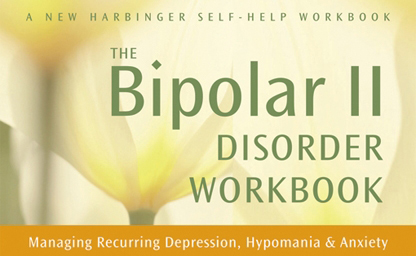Medication—like mood stabilizers, antidepressants, and atypical antipsychotics (as well as off-label medications or those used to treat comorbid conditions)—is typically an integral component of successful bipolar treatment. As the authors of our Bipolar II Disorder Workbook outline, medication is key, but is even more effective when therapists combine it with skills-based therapies to help clients manage their symptoms.
While bipolar II (BPII) disorder is a biological illness, it is also heavily influenced by environmental conditions, making a multipronged approach preferable to pharmacological intervention alone. Bipolar II is a perfect condition to which we can apply the diathesis-stress model (Ingram and Luxton, 2005), examining how the biological makeup of the BPII sufferer interacts with environmental stimuli differently than that of a mentally healthy person or someone with a different psychological condition. We’re all subject to external influences, like trauma or stress-inducing situations; but someone with a genetic predisposition for an illness like BPII has more incentive to develop skills to manage and control responses to unpleasant external stimuli like stress.
Stephanie Roberts, Louisa Sylvia, and Noreen Reilly-Harrington outline six different schools of psychotherapy used to treat BPII:
1. Cognitive behavioral therapy (CBT)
CBT, a combination of cognitive and behavioral therapies, is one of the most well-known and widely utilized models. Goals while undergoing CBT treatment will be to change dysfunctional thoughts and their resulting behaviors. CBT is generally most effective at treating the depressive symptoms of BPII.
2. Dialectical behavior therapy (DBT)
DBT, by focusing on increasing and maintaining awareness of one’s own thoughts, behaviors, and feelings, emphasizes a mindfulness and acceptance approach. DBT relies heavily on validation: a patient is encouraged to accept his or her overwhelming emotions as they are, leading to a higher distress tolerance threshold.
3. Mindfulness-Based Cognitive Therapy (MBCT)
Though MBCT was originally developed to treat depressive episodes, it has been successfully applied to the management of bipolar disorder. It emphasizes mindfulness, encouraging the client to focus on and live intentionally in the present moment.
4. Family-focused treatment (FFT)
FFT skills are great tools for managing stress and enabling better communication among the client and his or her family members. With an emphasis on examining expressed emotion, family members learn how to modify their levels of critical, hostile, or over-involved attitudes and behaviors.
5. Interpersonal and social rhythm therapy (IPSRT)
IPSRT is rooted in the premise that creating a structured routine can help reduce depressive symptoms. Establishing a daily routine, including the practice of proper sleep hygiene, eating habits, and exercise, is a vital piece of BPII treatment.
6. Psychoeducation (PE)
The central focus of PE is education; viewing bipolar disorder as a biological illness, this treatment model relies on teaching the client about medication compliance. It is usually given in groups for a set number of sessions.
References
Ingram, R.E. and D.D. Luxton. 2005. “Vulnerability-Stress Models.” In Development of Psychopathology: A Vulnerability-Stress Perspective, edited by B.L. Hankin and J.R.Z. Abela, 32—46. Thousand Oaks, CA: Sage Publications.


 2024 Peace Playbook: 3 Tactics to Avoid Clashes with Your Partner
2024 Peace Playbook: 3 Tactics to Avoid Clashes with Your Partner